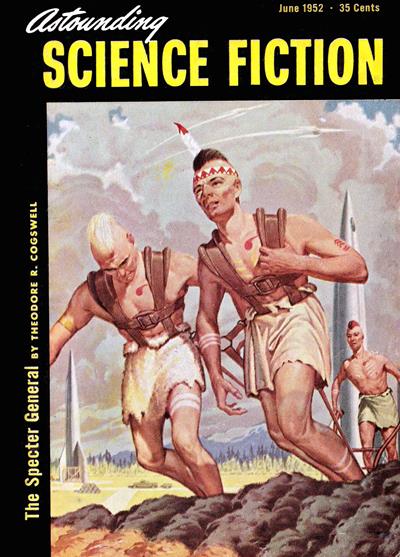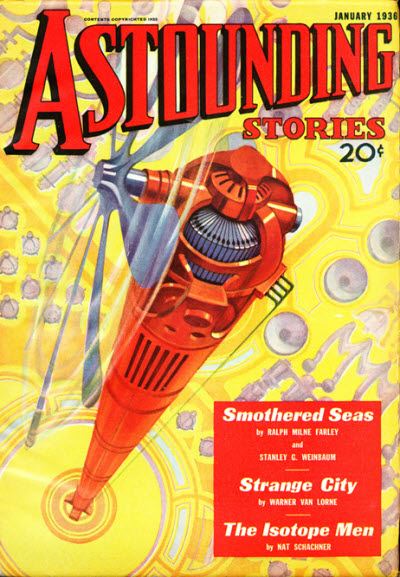
Part of Series
Vol 3, No. 3. Audiobook version of the September 1930 issue of Astounding Stories (total running time: 8:21:00). Contents: - A Problem in Communication / Miles J. Breuer, M.D. - Jetta of the Lowlands (Part 1 of 3) / Ray Cummings - The Terrible Tentacles of L-472 / Sewell Peaslee Wright - Marooned Under the Sea / Paul Ernst - The Murder Machine / Hugh B. Cave - The Attack From Space / S.P. Meek - Earth, the Marauder (Part 3 of 3) / Arthur J. Burks. 【 PREVIOUS ISSUE ← September 1930 → NEXT ISSUE 】
Authors

Hugh Barnett Cave was a prolific writer of pulp fiction who also excelled in other genres. Sources differ as to when Cave sold his first story: some say it was while he still attended Brookline High School, others cite "Island Ordeal", written at age 19 in 1929 while still working for the vanity press. In his early career he contributed to such pulp magazines as Astounding, Black Mask, and Weird Tales. By his own estimate, in the 1930s alone, he published roughly 800 short stories in nearly 100 periodicals under a number of pseudonyms. Of particular interest during this time was his series featuring an independent gentleman of courageous action and questionable morals called simply The Eel. These adventures appeared in the late 1930s and early 40s under the pen name Justin Case. Cave was also one of the most successful contributors to the weird menace or "shudder pulps" of the 1930s. In 1943, drawing on his experience as a war reporter, he authored one of his most highly regarded novels, Long Were the Nights, telling of the first PT boats at Guadalcanal. He also wrote a number of other books on the war in the Pacific during this period. During his post-war sojourn in Haiti, he became so familiar with the religion of Voodoo that he published Haiti: High Road to Adventure, a nonfiction work critically acclaimed as the "best report on voodoo in English." His Caribbean experiences led to his best-selling Voodoo-themed novel, The Cross On The Drum (1959), an interracial story in which a white Christian missionary falls in love with a black Voodoo priest's sister. During this midpoint in his career Cave advanced his writing to the "slick" magazines, including Collier's, Family Circle, Ladies' Home Journal, Redbook, and the Saturday Evening Post. It was in this latter publication, in 1959, that "The Mission," his most popular short story, appeared—subsequently issued in hardcover by Doubleday, reprinted in textbooks, and translated into a number of languages. But his career took a dip in the early 1970s. According to The Guardian, with the golden era of pulp fiction now in the past, Cave's "only regular market was writing romance for women's magazines." He was rediscovered, however, by Karl Edward Wagner, who published Murgunstrumm and Others, a horror story collection that won Cave the 1978 World Fantasy Award. Other collections followed and Cave also published new horror fiction. His later career included the publication in the late 1970s and early 1980s of four successful fantasy novels: Legion of the Dead (1979), The Nebulon Horror (1980), The Evil (1981), and Shades of Evil (1982). Two other notable late works are Lucifer's Eye (1991) and The Mountains of Madness (2004). Moreover, Cave took naturally to the Internet, championing the e-book to such an extent that electronic versions of his stories can readily be purchased online. Over his entire career he wrote more than 1,000 short stories in nearly all genres (though he is best remembered for his horror and crime pieces), approximately forty novels, and a notable body of nonfiction. He received the Phoenix Award as well as lifetime achievement awards from the International Horror Guild, the Horror Writers Association, and the World Fantasy Convention. (From Wikipedia.) Used the pseudonyms John Starr and Justin Case

Paul Frederick Ernst was an American pulp fiction writer. He is best known as the author of the original 24 "Avenger" novels, published by Street & Smith under the house name Kenneth Robeson. He "[took] up fiction writing in his early twenties." Credited by pulp-expert Don Hutchison as "a prolific manufacturer of potboilers-made-to-order," his stories appeared in a number of early Science fiction and fantasy magazines. His writing appeared in Astounding Stories, Strange Tales and Amazing, and he was the author of the Doctor Satan series which ran in Weird Tales from August, 1935. His most famous work was in writing the original 24 The Avenger stories in the eponymous magazine between 1939 and 1942. When pulp magazine work began to dry up, Ernst "was able to make a painless transition into the more prestigious "slick" magazines, where his word skill earned him higher financial rewards." As of 1971, he was "still active as a writer," including penning "Blackout" for the July 1971 issue of Good Housekeeping magazine. He died in Pinellas County, Florida. [https://en.m.wikipedia.org/wiki/Paul\_...] Librarian note: There is more than one author in the Goodreads database with this name. Paul^Ernst



